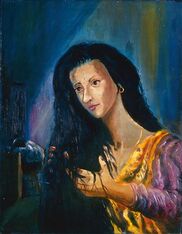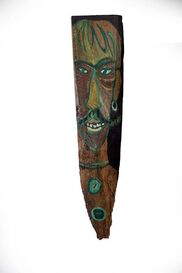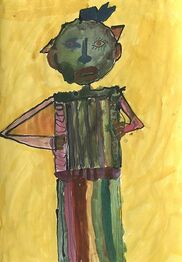Concentration Camp
created: 06. 09. 2022 13:12 modified: 06. 09. 2022 13:13
The author of the painting is the painter Jozef Fečo. The painting is a part of the 11-pieces collection of pictures covering the events of the Romani Holocaust. The author found the inspiration in the literary work of Elena Lacková, specifically in her novel The Dead Never Return. The collection was created with support of the stipend provided by the Fund for Minorities’ Culture Development SR.
The author provides description of the painting by the quoting the novel:
"When they found out that Jenko was blind, they tore off his clothes and dragged him into the so-called bathroom. Men, women and children entered with him. There were so many of them that Jenko couldn't even move. Foreign bodies rubbed against him, he felt fear, the children began to cry.
Suddenly everything went quiet. The door slammed. Instead of water, there was a hiss from the showers above their heads. The SS let off the gas. In a moment, only the desperate moans of suffocating people, calls for help and banging on the door could be heard inside. Jenko was crying until the last moment: Sarika, my dear, where are you, call me! But his cries and sobs were choked by the gas in his throat.
When all was quiet in the chamber, the death squad ventilated the room and the cleaners came to drag the corpses to the crematorium."
Jozef Fečo is a graduate of the Secondary Art School in Prešov, majoring in design and artistic wood shaping. He is primarily interested in the facial expressions of human faces, their expressive value and typical personality traits. For the State Science Library in Prešov, he created a series of 23 large-format paintings in 2015 and 2019 called Unknown Colours of Personalities.
category: fine arts
tags: secular material artistic 2D artifact painting Jozef Fečo general audience internal
Jozef Cichý - Home Alone
created: 04. 04. 2022 11:09 modified: 04. 04. 2022 11:31
The 51 cm x 65 cm drawing is the portrait of the young woman. The portrait’s name is “Home Alone”. The combined technique on plywood. The author of the portrait is Jozef Cichý. The painting was a part of the collection created by organization Jekhetane-Spolu which was supporting the work of the Romani artists. Jozef Cichý (1966-) is a painter of the Romani origin from the village Nižný Žipov in the district of Trebišov. The vehicle mechanic by profession, devoted many of his years of life to painting exclusively. His artwork is mainly influenced by Salvador Dali, Leonardo da Vinci, Michelangelo Buonarotti and Rafael Santi. He paints mostly with acrylic and oil colours on canvas or sololit. Several of his wall paintings are in churches and funeral houses. The main motives of his artwork are of sacral nature as well as family evironment, war and "romipen". In 90s of the past century he received award for painting in the Slovak competition of amateur art work in Trenčín. Among the works of other Romani artists were his paintings exhibited in Poland, in the Museum of the Romani Culture in Brno, in Bratislava at the exhibition titled Heartprints at the Pallette of Romani Artists, in Prešov, in Michalovce at the exhibition titled Romane čercheňa (Romani Stars) or in Stropkov. Currently, his paintings can be seen in aproximately 30 villages in funeral houses and churches, exhibited in the Museum of Romani Culture in Brno and in other places both in Slovakia and abroad.
category: fine arts
tags: secular material artistic 2D artifact painting Jozef Cichý general audience internal
Jozef Cichý - Zefirín Jiménez Malla
created: 04. 04. 2022 09:05 modified: 04. 04. 2022 09:12
The 71 cm x 51 cm painting depicts a portrait of Blessed Zefirín Jiménez Malla. The technique used is oil on hardboard.The author of the painting is Jozef Cichý. The painting was a part of the collection created by organization Jekhetane-Spolu which was supporting the work of the Romani artists. The artifact is not dated. It was many times exhibited at events organized by the Jekhetane-Spolu association, including one of the most famous exhibitions entitled We Paint for Love - Čitrinas perdal o kamiben within the Roma Traveling Gallery. Jozef Cichý (1966-) is a painter of the Romani origin from the village Nižný Žipov in the district of Trebišov. The vehicle mechanic by profession, devoted many of his years of life to painting exclusively. His artwork is mainly influenced by Salvador Dali, Leonardo da Vinci, Michelangelo Buonarotti and Rafael Santi. He paints mostly with acrylic and oil colours on canvas or sololit. Several of his wall paintings are in churches and funeral houses. The main motives of his artwork are of sacral nature as well as family evironment, war and "romipen". In 90s of the past century he received award for painting in the Slovak competition of amateur art work in Trečín. Among the works of other Romani artists were his paintings exhibited in Poland, in the Museum of the Romani Culture in Brno, in Bratislava at the exhibition titled Heartprints at the Pallette of Romani Artists, in Prešov, in Michalovce at the exhibition titled Romane čercheňa (Romani Stars) or in Stropkov. Currently, his paintings can be seen in approximately 30 villages in funeral houses and churches, exhibited in the Museum of Romani Culture in Brno and in other places both in Slovakia and abroad.
category: fine arts
tags: secular material artistic 2D artifact painting Jozef Cichý Zefirín Jiménez Malla general audience internal
Jozef Cichý - The Portrait of Jaroslav Cicko
created: 04. 04. 2022 08:53 modified: 04. 04. 2022 08:59
The painting on plywood, 51 cm x 71 cm, is the portrait of the Romani carver Jaroslav Cicko. The author of the painting is Jozef Cichý. The painting was a part of the collection created by organization Jekhetane-Spolu which was supporting the work of the Romani artists. The artifact was made in 2001. Since then it was many times exhibited at events organized by the Jekhetane-Spolu association, including one of the most famous exhibitions entitled We Paint for Love - Čitrinas perdal o kamiben within the Roma Traveling Gallery. Jozef Cichý (1966-) is a painter of the Romani origin from the village Nižný Žipov in the district of Trebišov. The vehicle mechanic by profession, devoted many of his years of life to painting exclusively. His artwork is mainly influenced by Salvador Dali, Leonardo da Vinci, Michelangelo Buonarotti and Rafael Santi. He paints mostly with acrylic and oil colours on canvas or sololit. Several of his wall paintings are in churches and funeral houses. The main motives of his artwork are of sacral nature as well as family evironment, war and "romipen". In 90s of the past century he received award for painting in the Slovak competition of amateur art work in Trenčín. Among the works of other Romani artists were his paintings exhibited in Poland, in the Museum of the Romani Culture in Brno, in Bratislava at the exhibition titled Heartprints at the Pallette of Romani Artists, in Prešov, in Michalovce at the exhibition titled Romane čercheňa (Romani Stars) or in Stropkov. Currently, his paintings can be seen in approximately 30 villages in funeral houses and churches, exhibited in the Museum of Romani Culture in Brno and in other places both in Slovakia and abroad.
Jaroslav Cicko is a well-known Romani artist and sculptor who created his works mainly from wood, but also stone.
He was born on March 25, 1939 in Martin and died on November 18, 2010 in Horná Štubňa in the district of Turčianske Teplice.
He worked as a toolmaker at the Heavy Engineering Plant in Martin and as a carver at the Martin Studio of Non-Professional Artists. He was a lecturer at symposia of non-professional artists.
In 2000, he exhibited his works and demonstrated various methods of creating his works in Germany, the Czech Republic, Spain, France and Italy.
The most common motif of his works is a woman in all her forms.
category: fine arts
tags: secular material artistic 2D artifact painting Jozef Cichý Jaroslav Cicko general audience internal
Radoslav Giňa - A Man's Face
created: 13. 01. 2022 14:05 modified: 13. 01. 2022 14:06
The author of the painting is Radoslav Giňa, a pupil of the Elementary School in Jarovnice. He made the painting at the age of 11 while attending the 5th grade. The painting was made in 2008. The name of the painting was given by a cataloguer.
Painting on wood was initiated by Jan Sajko. This kind of creative work with his students started in 1986. He was using waste wood of various sorts, best with flaws at those determined the way of future painting.
The painting is made of wood measuring 31 cm (width at the widest part) x 37.5 cm (height). The thickness of the wood is 3 cm on the widest side. The thickness gradually decreases. The structure of the wood is bark on the sides. On the back is written the name of the author, his age and year of painting, at the top is a hanging system.
category: fine arts
tags: secular material artistic 3D artifact painting Radoslav Giňa general audience internal
A Smiling Man
created: 13. 01. 2022 13:30 modified: 13. 01. 2022 13:37
The painting of wood depicts the face of a smiling man. The author of the painting is Roman Husár, the pupil from the Elementary School in Jarovnice. He painted the object at 11 years old when attended the 5th grade. The year when the painting was painted is not mentioned at the descriptive label. The painting's name is written in English: The Smiling Man.
Painting on wood was initiated by Jan Sajko. This kind of creative work with his students started in 1986. He was using waste wood of various sorts, best with flaws at those determined the way of future painting.
The painting is painted on a piece of wood, 21 cm in the width at its widest part, 93,5 cm of height. The thickness of the wood is 2 cm in the thickest part, the thickness gradually decreases. The backside is labeled with descriptive label, the handle is on the upper part.
category: fine arts
tags: secular material artistic 3D artifact painting Roman Husár general audience internal
Landscape
created: 13. 01. 2022 13:04 modified: 13. 01. 2022 13:05
The painting on wood depicts the landscape with three wooden houses. The author of the painting is Lukáš Giňa, the pupil from the Elementary School in Jarovnice. He painted the object at 11 years old when attended the 5th grade. The year when the painting was painted is not mentioned at the descriptive label. The painting's name is Landscape.
Painting on wood was initiated by Jan Sajko. This kind of creative work with his students started in 1986. He was using waste wood of various sorts, best with flaws at those determined the way of future painting.
The painting is painted on a piece of wood, 22 cm in the width at its widest part, 21 cm of height. The thickness of the wood is 2 cm in the thickest part, the thickness gradually decreases. The backside is labeled with descriptive label, the handle is on the upper part.
category: fine arts
tags: secular material artistic 3D artifact painting Lukáš Giňa general audience internal
Accordeonist
created: 22. 12. 2021 11:19 modified: 22. 12. 2021 11:19
The painting of a musician. Painted by Kristián Husár, a pupil of the Primary School in 192 Jarovnice. Painted on drawing paper of A3 type, created in 2015. It depicts a male musician playing accordion.
On the back of the drawing is a label with identification information about the school, the author and the title of the painting in English.
The school is known for winning many awards for the art work of its students, both at home and abroad (India, Japan, Portugal, USA, Czech Republic, Hungary, Slovenia, Northern Macedonia, Sweden, Norway, Finland, Iran, etc.). The pupils are taught by Mgr. Ján Sajko. They exhibited independently in many cities, e.g. in Washington D.C., Boston, Palm Beach, Hannover, Strassbourg, Brussels, Graz, Warsaw, Vienna, Prague, Budapest, Cracow, Bratislava, Košice, Martin, Prešov, Sabinov. The young authors come from socially disadvantaged environment.a.
category: fine arts
tags: secular material artistic 2D artifact painting Kristián Husár general audience internal
Katarína Taikon Langhammer
created: 08. 07. 2021 10:46 modified: 08. 07. 2021 10:51
The author of the portrait is the Romani artist Jozef Fečo. The portrait is one of the outcomes of the project Roma Theater – Secret Values of the Largest Minority in the Visegrad Region (2020); the project was supported by the International Visegrad Fund. The portrait is painted on canvas, the genre is street art. The measures of the portrait are 100 cm x 120 cm. The picture is in the frame.
KATARINA TAIKON LANGHAMMER
She was born on July 29, 1932, Almby, Sweden. She was a Swedish Roma activist, leader of the civil rights movement, writer and actress, from the Roma group Kalderash. The sister of the jeweler Rosa Taikon. Through her political and media activity, she fought for the acquisition of civil rights for the Roma in Sweden. She managed to change the main stereotypical views of the major society through her literary work; between the years 1963 and 1980 she published 16 sequels of children's books about the Roma girl Katitzi. Her stories are still very popular, even films were made of them. Katarina Taikon, for her political activism, is often compared to Martin Luther King. She died on 30 December 1995, Ytterhogdal, Sweden.
category: fine arts
tags: secular material artistic 2D artifact painting Jozef Fečo Katarína Taikon general audience internal
Cinka Panna
created: 08. 07. 2021 10:29 modified: 08. 07. 2021 10:31
The author of the portrait is the Romani artist Jozef Fečo. The portrait is one of the outcomes of the project Roma Theater – Secret Values of the Largest Minority in the Visegrad Region (2020); the project was supported by the International Visegrad Fund. The portrait is painted on canvas, the genre is street art. The measures of the portrait are 100 cm x 120 cm. The picture is in the frame.
CINKA PANNA
She was born in 1711 in Gemer, Hungarian Kingdom. A violin virtuoso, multi instrumentalist, lead violinist of a Romani band, composer, also called "Gypsy Sapfó". She came from a family of Romani musicians. She was tutored by the local nobleman Láni, who sponsored her study of music in Rožňava. Together with her husband Dányi, a cellist, she founded a band where she was both a lead violinist and a composer. She performed dressed in men's clothing, which had elements of a kuruc uniform. She wrote her works in the book Hungarian Collection in 1730. She is the author of short compositions - halgato. She died on February 5, 1772 in Gemer, Hungarian Kingdom.
category: visual art
tags: secular material artistic 2D artifact painting Jozef Fečo general audience internal

















